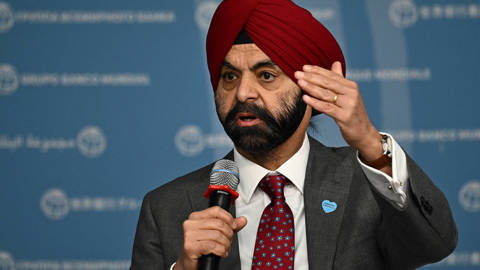Improving energy efficiency is not enough for advocates of degrowth, who espouse energy sufficiency as the best way to fight climate change. But their argument is absurd: using limited inputs more efficiently is the definition of economic productivity – which, in turn, boosts growth.
CAMBRIDGE/NEW YORK – Improving energy efficiency is undoubtedly a good thing. But efficiency should not be confused – as it sometimes is – with sufficiency, which calls for limiting energy consumption and is thus closely connected to the degrowth movement. Tackling climate change means doing more with less, not simply doing less.
The idea that sufficiency, and by association degrowth, could serve as a blueprint for reaching our climate goals gained traction after the COVID-19 lockdowns, when humans retreated indoors and global carbon dioxide emissions fell sharply, and Russia’s invasion of Ukraine, which triggered energy-security concerns in Europe. In our hyper-consumerist society, the argument goes, consumption offers diminishing returns for human happiness, which implies that embracing minimalism would yield a double dividend: environmental preservation and improved well-being. Under this approach, wealthy countries would stop expanding their economies, while even the most strident degrowth advocates contend that poorer countries would still need to boost consumption and investment to escape destitution.
If this sounds too good to be true, that’s because it is. First, some clarifications. Degrowth calls for an absolute reduction in consumption, rather than merely a shift in its composition. But such shifts – such as ditching the car and commuting by bicycle – have been a constant throughout history, and are what green growth strategies aim to achieve. To be sure, there is nothing wrong with slowing down and choosing to earn less (and apparently achieving inner peace in the process). But one should not be led to believe that doing so holds the key to addressing the climate crisis.
Consider a simple thought experiment. Let’s start with the global economy in a steady state, neither growing nor contracting, and assume an annual decarbonization rate of 2.4% – our calculation of the average over the past two decades, based on IMF economic statistics and emissions data from the Global Carbon Project. In such a world, global CO2 emissions would fall by 48% by 2050. While far from reaching the goal of net-zero emissions, this hypothetical global economy would be nearly twice as carbon-efficient as today’s.
Now imagine if decarbonization were to depend entirely on decreasing economic output. To achieve the same outcome – almost halving global CO2 emissions – world GDP would need to shrink by 5% every year for the next three decades. To put this in perspective, global GDP contracted by 2.7% in 2020, at the height of the pandemic. As successful as lockdowns were at slowing the spread of COVID-19, they were a terrible way to cut CO2 emissions.
Limiting this thought experiment to rich countries – as degrowthers propose – makes a weak argument an absurd one. Economic output in the G7 countries would need to shrink 17% in 2024 alone, followed by an annual shock the size of the Great Depression. By 2030, purchasing power in the G7 would be roughly equivalent to South Sudan’s today. How many climate-conscious Western consumers would be willing to endure this?
What’s more, this thought experiment is necessarily limited. Our hypothetical began with a zero-growth economy, whereas over the past two decades global per capita GDP has grown by 6.8% annually. Coupled with an increase in population, this steady growth has contributed to rising, not falling, CO2 emissions. Nothing short of a clean-energy revolution, complete with clean transport systems and industry, will turn the climate ship around. Moreover, achieving net-zero emissions requires trillions of dollars in investment, which will add to, not subtract from, economic growth.
That is not to say that improving energy efficiency is futile. In 2007, the United States passed a law that helped phase out incandescent lightbulbs. As shown by McKinsey’s famous marginal abatement cost curve in 2010, there were large monetary savings associated with switching from incandescent to LED bulbs. But this does not imply that the change would have happened automatically. Instead, it shows that the policy paid for itself, with Americans free to spend or save the leftover money. Either way, economic growth was inevitable.
The growth potential for large-scale efficiency improvements is significantly greater than that from switching to LED lightbulbs. In fact, using limited inputs more efficiently is the definition of economic productivity – which, in turn, boosts growth. Moreover, the need to accelerate our economies’ decarbonization requires rolling out green technologies at a much faster pace. Staving off climate catastrophe will require more growth, not because ever-increasing GDP – itself a fundamentally inadequate metric – is the end goal, but because it is the result of cutting emissions fast enough.











CAMBRIDGE/NEW YORK – Improving energy efficiency is undoubtedly a good thing. But efficiency should not be confused – as it sometimes is – with sufficiency, which calls for limiting energy consumption and is thus closely connected to the degrowth movement. Tackling climate change means doing more with less, not simply doing less.
The idea that sufficiency, and by association degrowth, could serve as a blueprint for reaching our climate goals gained traction after the COVID-19 lockdowns, when humans retreated indoors and global carbon dioxide emissions fell sharply, and Russia’s invasion of Ukraine, which triggered energy-security concerns in Europe. In our hyper-consumerist society, the argument goes, consumption offers diminishing returns for human happiness, which implies that embracing minimalism would yield a double dividend: environmental preservation and improved well-being. Under this approach, wealthy countries would stop expanding their economies, while even the most strident degrowth advocates contend that poorer countries would still need to boost consumption and investment to escape destitution.
If this sounds too good to be true, that’s because it is. First, some clarifications. Degrowth calls for an absolute reduction in consumption, rather than merely a shift in its composition. But such shifts – such as ditching the car and commuting by bicycle – have been a constant throughout history, and are what green growth strategies aim to achieve. To be sure, there is nothing wrong with slowing down and choosing to earn less (and apparently achieving inner peace in the process). But one should not be led to believe that doing so holds the key to addressing the climate crisis.
Consider a simple thought experiment. Let’s start with the global economy in a steady state, neither growing nor contracting, and assume an annual decarbonization rate of 2.4% – our calculation of the average over the past two decades, based on IMF economic statistics and emissions data from the Global Carbon Project. In such a world, global CO2 emissions would fall by 48% by 2050. While far from reaching the goal of net-zero emissions, this hypothetical global economy would be nearly twice as carbon-efficient as today’s.
Now imagine if decarbonization were to depend entirely on decreasing economic output. To achieve the same outcome – almost halving global CO2 emissions – world GDP would need to shrink by 5% every year for the next three decades. To put this in perspective, global GDP contracted by 2.7% in 2020, at the height of the pandemic. As successful as lockdowns were at slowing the spread of COVID-19, they were a terrible way to cut CO2 emissions.
Limiting this thought experiment to rich countries – as degrowthers propose – makes a weak argument an absurd one. Economic output in the G7 countries would need to shrink 17% in 2024 alone, followed by an annual shock the size of the Great Depression. By 2030, purchasing power in the G7 would be roughly equivalent to South Sudan’s today. How many climate-conscious Western consumers would be willing to endure this?
SPRING SALE: Save 40% on all new Digital or Digital Plus subscriptions
Subscribe now to gain greater access to Project Syndicate – including every commentary and our entire On Point suite of subscriber-exclusive content – starting at just $49.99.
Subscribe Now
What’s more, this thought experiment is necessarily limited. Our hypothetical began with a zero-growth economy, whereas over the past two decades global per capita GDP has grown by 6.8% annually. Coupled with an increase in population, this steady growth has contributed to rising, not falling, CO2 emissions. Nothing short of a clean-energy revolution, complete with clean transport systems and industry, will turn the climate ship around. Moreover, achieving net-zero emissions requires trillions of dollars in investment, which will add to, not subtract from, economic growth.
That is not to say that improving energy efficiency is futile. In 2007, the United States passed a law that helped phase out incandescent lightbulbs. As shown by McKinsey’s famous marginal abatement cost curve in 2010, there were large monetary savings associated with switching from incandescent to LED bulbs. But this does not imply that the change would have happened automatically. Instead, it shows that the policy paid for itself, with Americans free to spend or save the leftover money. Either way, economic growth was inevitable.
The growth potential for large-scale efficiency improvements is significantly greater than that from switching to LED lightbulbs. In fact, using limited inputs more efficiently is the definition of economic productivity – which, in turn, boosts growth. Moreover, the need to accelerate our economies’ decarbonization requires rolling out green technologies at a much faster pace. Staving off climate catastrophe will require more growth, not because ever-increasing GDP – itself a fundamentally inadequate metric – is the end goal, but because it is the result of cutting emissions fast enough.